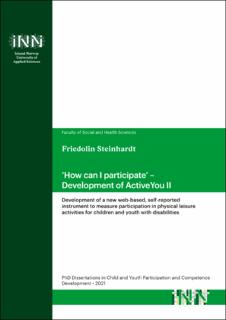| dc.description.abstract | Participation in physical leisure activities and sports plays an important role in the overall development and well-being of children and youth. The participation pattern of children and youth with disabilities differs from their non-disabled peers. Therefore, optimising participation has become one of the main goals for rehabilitation interventions, Valid instruments to measure the participation patterns, including facilitating and hindering factors are currently unavailable in the Norwegian setting.
Aim of this thesis was to develop a web-based self reported instrument of participation:
ActiveYou II
The process followed a in three phases, which adapted different interview-methods and a scoping review. In the first phase a scoping review was performed to explore the constructs of involvement and engagement, which represent the subjective aspects of participation. Thirtyseven publications from different fields of research were included. The results point to define involvement as the personal level of interest, motivation or arousal towards an activity, and engagement as the individual’s behavioural, cognitive, and affective investment during role performance. In the second phase, facilitating and hindering factors for participation were explored. Group interviews with children, parents, and professionals were conducted. The results showed that children focused on enjoyment and positive peer relationships as facilitators for participation. Parents and professionals talked about how the individual physical, cognitive, emotional, and social abilities of the children affected participation. Crucial factors for participation were the relationship with and support from parents, and the knowledge and attitude of activity leaders or professionals in the home environment. In the third phase, the first version of ActiveYou II was tested using cognitive interviews with children. Children articulated problems with comprehension and responding to different questions, mainly connected to formulations the children did not understand, or answer alternatives that were not clear enough or they were missing. ActiveYou II was then adjusted for further steps in development.
Summarized, this thesis covers several fundamental steps of the development of ActiveYou II. Further testing of psychometric properties is needed. In addition, the thesis contributes to the discussion on the understanding of the participation construct in the International Classification of Functioning, Disability, and Health (ICF) and the importance of including the perspective of children when exploring a topic concerning them. | en_US |
